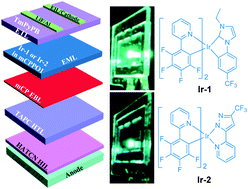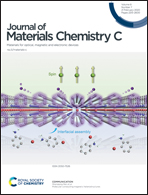Tetrafluorinated phenylpyridine based heteroleptic iridium(iii) complexes for efficient sky blue phosphorescent organic light-emitting diodes†
Abstract
It is one of the most difficult and challenging targets to achieve blue phosphorescent organic light-emitting diodes. Herein, we employ tetrafluorinated 2-phenylpyridine (F4ppy) as a cyclometalated ligand, in which the tetrafluorophenyl group contributes to the stabilization of the highest occupied molecular orbital (HOMO) of its iridium(III) complex. Meanwhile, N-heterocyclic carbene (NHC) and acidic pyrazolyl-pyridine (fppz) moieties as ancillary ligands are used to keep the lowest unoccupied molecular orbitals (LUMOs) of the phosphors relatively unchanged. Therefore, the energy gap between the HOMO and LUMO is enlarged and two sky blue emissive iridium(III) phosphors, named (F4ppy)2Ir(CF3-pei) (Ir-1) and (F4ppy)2Ir(fppz) (Ir-2), are achieved. Strong phosphorescent emission at a wavelength of around 460 nm with a photoluminescence quantum yield of around 60% is observed in solution for these two phosphors. Moreover, the organic light-emitting devices made from Ir-1 and Ir-2 exhibit high-efficiencies, affording peak current efficiencies (CEs) of 47.6 and 45.5 cd A−1 with external quantum efficiencies (EQEs) of 20.6% and 19.6%, respectively.



 Please wait while we load your content...
Please wait while we load your content...